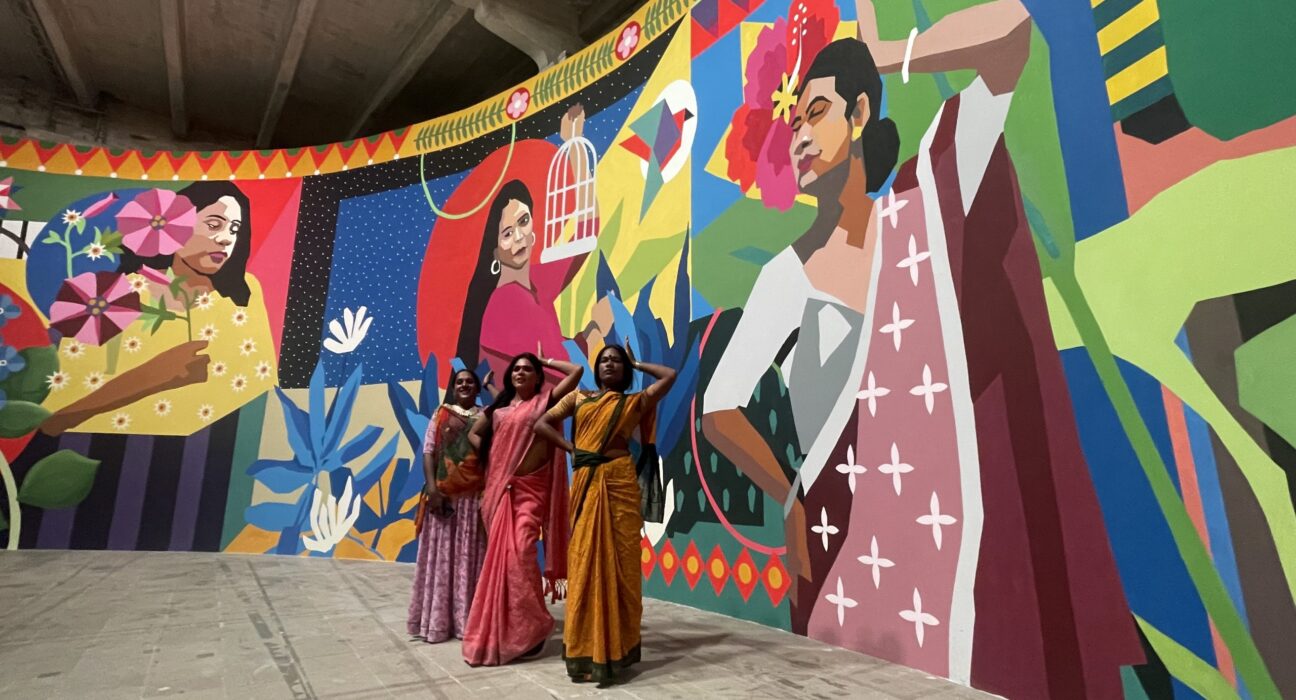To Karnika Bai, Shanthi Muniswamy, and Joythi H., the opening of their eye-catching, monumental mural Diaspore (2024) at the Arsenale was more than just a celebration of their Venice debut. It was also an event to mark the 10th anniversary of India’s recognition of transgender individuals, a defining moment that allowed these trans artists and their community to start to feel a little less foreign in their own country.
“If this edition’s theme, ‘Foreigners Everywhere,’ means being in different cultures and territories where you do not belong, this applies to us too” Bai, one of the lead artists from the Bangalore-based art collective Aravani Art Project, said in an interview during early hours of Tuesday’s pre-opening of the main exhibition of the 60th Venice Biennale curated by Adriano Pedrosa.
“We did not feel belong[ing] to the bodies that we were born into. People in our own country see us coming from another country, another culture. We are foreigners.”
While “Foreigners Everywhere” places exile, the marginalized, and the immigrant at the focal point of the exhibition featuring more than 330 artists and collectives, the work by Aravani Art Project pointed to another layer of understanding to the concept of “foreigner.”
The artists noted that members of the transgender community were wholly disregarded by the society in India. Their rights and needs were not recognized, and transwomen were seen by the mainstream as sex workers and beggars, they added. That only began to change exactly 10 years ago this week when the Supreme Court in India formally recognized transgenders as a “third gender” in a landmark judgement in response to concerns over the discrimination and harassment against them.

Xiyadie, Don’t Worry, Mom is Spinning Thread in the Next Room (A Love Scene When High School Student is at Home Writing Homework) (2019), featured at the Arsenale, Venice Biennale 2024. Photo: Vivienne Chow.
The artists have been part of the collective that works with the transgender community for eight years. They wanted to show the public that they are human beings and can pursue their dreams and individual freedoms like everyone else. Diaspore is a work about gender dysphoria and the journey of transition, the artists noted.
It is also a self-portrait. Joythi H, for example, is depicted holding an open bird cage releasing the imprisoned animal. The work contains motifs that relate to how transgender people find refuge in the physical body they feel comfortable with after transition. “We are no longer caged. We are free as a bird,” said Muniswamy.
Victor Brecheret, Virgin and Chile, featured in “Nucleo Storico Italians Everywhere,” Venice Biennale 2024. Photo: Vivienne Chow.
But they still have to deal with the discomfort and challenges of daily life. The artists said that when they applied for their passports to travel to Venice for the exhibition, they were questioned by the authorities repeatedly. “Why are you going to Venice? They asked why, why, why, just because of our identity,” Bai said. “But we are here. We are very proud to represent India and the transgender community.”
While the show shines a spotlight on works by queer, Indigenous, and diasporic artists, many of whom were previously unrepresented in the Venice event, some of the works on show also highlight the historical and political causes for such migration and repression, and the cultural influences they picked up along the way.
The section “Nucleo Storico” showcases dozens of works by Italian artists from the 20th century who traveled abroad and cultivated their oeuvre in the countries they resided, from Asia to Africa and the Americas. They all left the country for different reasons. They included those orientalists obsessed with the exoticism of Asia and Africa, convoys of the Italian colonial forces, and those who fled the fascist regime, antisemitic laws, and the country’s economic woes during World War II. The works are displayed on a glass easel, known as cavaletes de vidro, designed by Lina Bo Bardi, an Italian architect, designer, and exhibition maker who moved to Brazil in 1946.
The 60th Venice Biennale opens on April 20 and runs through November 24, 2024.
Follow Artnet News on Facebook:
Want to stay ahead of the art world? Subscribe to our newsletter to get the breaking news, eye-opening interviews, and incisive critical takes that drive the conversation forward.

